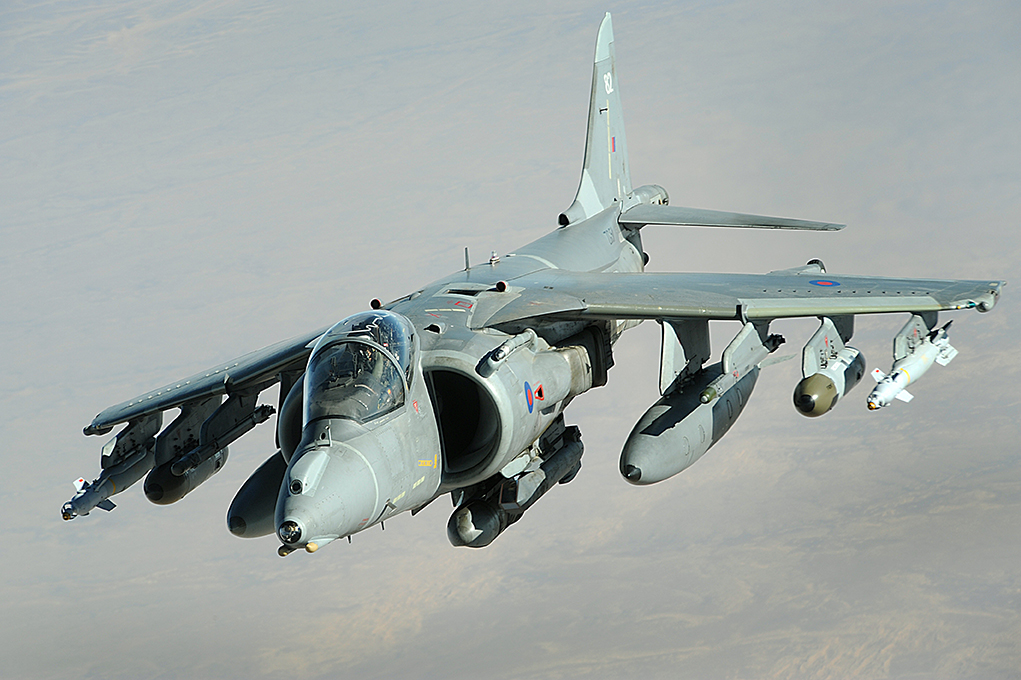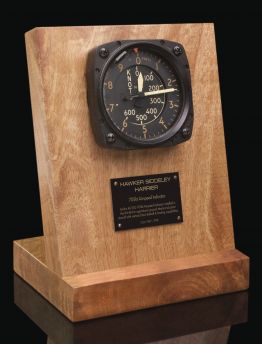- AUST POST SHIPPING
- 0438 654 235
- info@recoverycurios.com
- P.O. Box 7640 Cairns QLD Australia, 4870
-
0
Shopping Cart


HAWKER SIDDELEY HARRIER
 With the Cold War in full swing and tensions along the East and West German border at flash point, NATO strategics realised that their airbases would be priority targets during the early stages of any Soviet incursion. Such an attack
With the Cold War in full swing and tensions along the East and West German border at flash point, NATO strategics realised that their airbases would be priority targets during the early stages of any Soviet incursion. Such an attack  would take out most of NATOS’s conventional runway reliant, first response ground-attack aircraft.
would take out most of NATOS’s conventional runway reliant, first response ground-attack aircraft.
The solution came in the form of the British Hawker Siddeley Harrier, the first truly operational ‘jump jet’ with vertical/short takeoff and landing (V/STOL) capabilities.
 Introduced in the late 60s, the Harrier’s VTOL abilities allowed it to be deployed from small, hidden clearings or helipads as well as normal airfields.
Introduced in the late 60s, the Harrier’s VTOL abilities allowed it to be deployed from small, hidden clearings or helipads as well as normal airfields.
For British and NATO strategists, the ability to scatter Harrier Squadrons across a wide rage these isolated ‘alert  pads’ along the front lines, it gave them a significant advantage in ensuring the survival and strike response capabilities of their aircraft.
pads’ along the front lines, it gave them a significant advantage in ensuring the survival and strike response capabilities of their aircraft.
 V/STOL technology had been experimented with since the early 50s but had always been restricted by the lack of a suitable light-weight, reliable jet engine able to deliver the massive, controllable thrust required to lift an aircraft vertically rather than rely on high-speed airflow over the traditional lift and control surfaces.
V/STOL technology had been experimented with since the early 50s but had always been restricted by the lack of a suitable light-weight, reliable jet engine able to deliver the massive, controllable thrust required to lift an aircraft vertically rather than rely on high-speed airflow over the traditional lift and control surfaces.
 The breakthru came through the development of the Pegasus turbofan jet engine which featured a unique water injection system designed to generate the maximum thrust required for the vertical take off and landings. Coupled with advances in vectored thrust control systems, it made the Hawker Harrier a significant and elusive adversary.
The breakthru came through the development of the Pegasus turbofan jet engine which featured a unique water injection system designed to generate the maximum thrust required for the vertical take off and landings. Coupled with advances in vectored thrust control systems, it made the Hawker Harrier a significant and elusive adversary.
The turbofan jet was fitted with two air intakes and four vectoring nozzles for directing the thrust generated: two for the bypass flow and the remaining for the jet exhaust. Several smaller reaction nozzles were also fitted in the nose, tail and at the wingtips for balancing when in vertical operation. The Harrier also featured two landing gear units with one on the fuselage and two outrigger landing pods that could swing down from the wingtips at takeoff and landing.
 With so many thrust vectoring nozzles to control, the Harrier became known as an unforgiving aircraft amongst its pilots who required the skills and technical knowledge usually associated with flying helicopters. In fact, Harrier trainee pilots were often drawn from highly experienced and skilled helicopter pilots.
With so many thrust vectoring nozzles to control, the Harrier became known as an unforgiving aircraft amongst its pilots who required the skills and technical knowledge usually associated with flying helicopters. In fact, Harrier trainee pilots were often drawn from highly experienced and skilled helicopter pilots.
To assist the pilot, Hawker Siddeley designers were able to link the aircraft's vertical and forward controls to a single lever in the cockpit. or horizontal flight, the nozzles are directed rearwards by shifting the lever to the forward position; for short or vertical takeoffs and landings, the lever is pulled back to point the nozzles downwards.
 Whilst the Harrier’s flexibility led to long-term deployment in West Germany as a rapid response force against advancing armour columns from East Germany, Harriers were also deployed to bases in Norway and Belize in Central America where British forces had been stationed for several years due to tensions with the former British colony and it neighbour Guatemala.
Whilst the Harrier’s flexibility led to long-term deployment in West Germany as a rapid response force against advancing armour columns from East Germany, Harriers were also deployed to bases in Norway and Belize in Central America where British forces had been stationed for several years due to tensions with the former British colony and it neighbour Guatemala.
 Undoubtedly however, the Hawker Harrier owes it wider fame through its deployment during the Falklands War of 1982.
Undoubtedly however, the Hawker Harrier owes it wider fame through its deployment during the Falklands War of 1982.
In assembling its battle fleet in response to the Argentine invasion, 10 Harrier GR.3s of No. 1 Squadron were assigned to the aircraft carrier HMS Hermes. These normally land-based Harriers were missioned to provide close air support to the ground forces on the Falklands and to attack Argentine positions whilkst suppressing enemy artillery fire.
Unlike the Sea Harrier, which had been specifically built for naval operations, No 1 Squadron’s Harriers had to be rapidly modified force prior to departure of the main force. Special sealants against corrosion were applied and a new deck-based inertial guidance aid was devised to allow the RAF Harrier to land on a carrier as easily as the Sea Harrier. Transponders to guide aircraft back to the carriers during night-time operations were also installed, along with flares and chaff dispensers.
 Whilst No.1 Squadron were providing close air support to British ground forces, the Fleet’s Sea Harrier’s were conducting fleet air defence and combat air patrols against the threat of attacking Argentine fighters but if most of the Sea Harriers were lost, the usually land-based Harriers would have taken over the fleet protection duties.
Whilst No.1 Squadron were providing close air support to British ground forces, the Fleet’s Sea Harrier’s were conducting fleet air defence and combat air patrols against the threat of attacking Argentine fighters but if most of the Sea Harriers were lost, the usually land-based Harriers would have taken over the fleet protection duties.
Sea Harriers were also used in the war, primarily conducting fleet air defence and combat air patrols against the threat of attacking Argentine fighters. However, both Sea Harriers and Harrier GR.3s were used in ground-attack missions against the main airfield and runway at Stanley.
 During the Falklands campaign, the greatest threats to the Harriers were deemed to be surface-to-air missiles (SAMs) and small arms fire from the ground. In total, four Harrier GR.3s and six Sea Harriers were lost to ground fire, accidents, or mechanical failure. More than 2,000 Harrier sorties were conducted during the conflict—equivalent to six sorties per day per aircraft.
During the Falklands campaign, the greatest threats to the Harriers were deemed to be surface-to-air missiles (SAMs) and small arms fire from the ground. In total, four Harrier GR.3s and six Sea Harriers were lost to ground fire, accidents, or mechanical failure. More than 2,000 Harrier sorties were conducted during the conflict—equivalent to six sorties per day per aircraft.
 The United States Marine Corp had long recognised the potential of the Harriers versatility from its first introduction into service with the RAF and placed an order for 102 of the AV-8A variant in the mid 70’s, The USMC used the Harrier primarily for close air support, operating from amphibious assault ships, and, if needed, forward operating bases.
The United States Marine Corp had long recognised the potential of the Harriers versatility from its first introduction into service with the RAF and placed an order for 102 of the AV-8A variant in the mid 70’s, The USMC used the Harrier primarily for close air support, operating from amphibious assault ships, and, if needed, forward operating bases.
The AV-8A variant required the removal of all magnesium components, which corroded quickly at sea, and the integration of American radios and Identification Friend or Foe (IFF) systems; furthermore the outer pylons, unlike the RAF aircraft, were designed from delivery to be equipped with self-defence AIM-9 Sidewinder heat-seeking air-to-air missiles.
The Hawker Harrier was retired from service in 2006.
 All Hawker Harrier instruments listed below come complete with a detailed, custom-built Scale Model of the Hawker Harrier aircraft on its Magnetic Display Arm; Mango Wood Display Stand & Plaque, plus Printed Fact Sheet featuring photo of instrument in aircraft cockpit - as shown in this F-86 Sabre example here:
All Hawker Harrier instruments listed below come complete with a detailed, custom-built Scale Model of the Hawker Harrier aircraft on its Magnetic Display Arm; Mango Wood Display Stand & Plaque, plus Printed Fact Sheet featuring photo of instrument in aircraft cockpit - as shown in this F-86 Sabre example here:
Return to VINTAGE ORIGINAL AIRCRAFT INSTRUMENTS
- LAND
- SEA
- AIR
- VINTAGE ORIGINAL AIRCRAFT INSTRUMENTS
- HAWKER TYPHOON
- VICKERS WELLINGTON
- FAIREY GANNET
- RYAN ST-A SPORTS TRAINER
- DE HAVILLAND TIGER MOTH
- HAWKER HUNTER
- Mc DONNELL DOUGLAS KC-10 AERIAL TANKER
- SOPWITH CAMEL
- AIRCO DH.1 AND DH.2
- JUNKERS JU 87
- CURTISS C-46 COMMANDO
- HANDLEY PAGE HAMPDEN
- SUPERMARINE SEAFIRE
- B-25 MITCHELL BOMBER
- BRISTOL BLENHEIM
- ENGLISH ELECTRIC LIGHTNING
- HAWKER TEMPEST MkVI
- YAKOVELOV YAK - 3
- FOCKE-WULF FW190
- FOLLAND GNAT
- AIRSPEED OXFORD
- SHORT STIRLING
- AVRO ANSON
- DOUGLAS C-133 CARGOMASTER
- HANDLEY PAGE VICTOR BOMBER
- DE HAVILLAND SEA VENOM
- VICKERS VALIANT BOMBER
- DOUGLAS A-26 INVADER
- GRUMMAN S2F TRACKER
- SUPERMARINE SPITFIRE
- LOCKHEED P2-V NEPTUNE
- P-51 MUSTANG
- BRISTOL BEAUFIGHTER
- DE HAVILLAND MOSQUITO
- B-26 MARTIN MARAUDER
- P3 ORION
- DOUGLAS A-20 HAVOC
- P-39 AIRACOBRA
- AVRO SHACKLETON
- B-17 FLYING FORTRESS
- B-24 LIBERATOR
- MESSERSCHMITT BF-110
- MESSERSCHMITT BF-109
- BRISTOL BEAUFORT
- KAWASAKI Ki-45 (NICK) INTERCEPTOR
- C-130 HERCULES
- CAC BOOMERANG
- AVRO LANCASTER
- GRUMMAN F4F WILDCAT
- F4U VOUGHT CORSAIR
- WESTLAND LYSANDER
- P-47 REPUBLIC THUNDERBOLT
- NORTH AMERICAN T-6 TEXAN - HAVARD
- C-47 SKYTRAIN
- DOUGLAS SBD DAUNTLESS
- CAC WIRRAWAY
- PBY CATALINA
- P-40 WARHAWK
- FAIREY SWORDFISH
- P-38 LIGHTNING
- HAWKER HURRICANE
- CURTISS SB2C HELLDIVER
- GRUMMAN F6F HELLCAT
- SEAKING HELICOPTER
- SEAHAWK HELICOPTER
- DOUGLAS A4G SKYHAWK
- GRUMMAN TBF AVENGER
- HANDLEY PAGE HALIFAX
- DOUGLAS SKYRAIDER AE-1
- GLOSTER METEOR
- JUNKERS JU-88
- F-86 SABRE JET
- SHORT SUNDERLAND
- B-29 SUPER FORTRESS
- F-9F GRUMMAN PANTHER
- F-100D SUPER SABRE
- BELL UH-1 HUEY HELICOPTER
- AVRO VULCAN STRATEGIC BOMBER
- CANBERRA BOMBER
- DHC-4 CARIBOU
- BLACKBURN BUCCANEER
- DE HAVILLAND VAMPIRE JET
- HAWKER SEA FURY
- LOCKHEED HUDSON
- LOCKHEED EC-121 WARNING STAR
- SEPECAT JAGUAR
- HAWKER SIDDELEY NIMROD
- HAWKER SIDDELEY HARRIER
- ARADO AR 196
- VOUGHT OS2U KINGFISHER
- LOCKHEED ELECTRA
- NORTHROP P-61 BLACK WIDOW
- BOEING CH-47 CHINOOK
- LOCKHEED PV-1 VENTURA
- BOEING P26-A 'PEASHOOTER'
- Ilyushin Il-2 ‘Sturmovik’
- WESTLAND WESSEX
- FAIREY FIREFLY
- VINTAGE AVIATION COLLECTABLES
- VINTAGE COLLECTABLE MODEL AIRCRAFT KITS
- RETRO STYLE METAL AIRCRAFT COLLECTABLES
- VINTAGE ORIGINAL AIRCRAFT INSTRUMENTS
